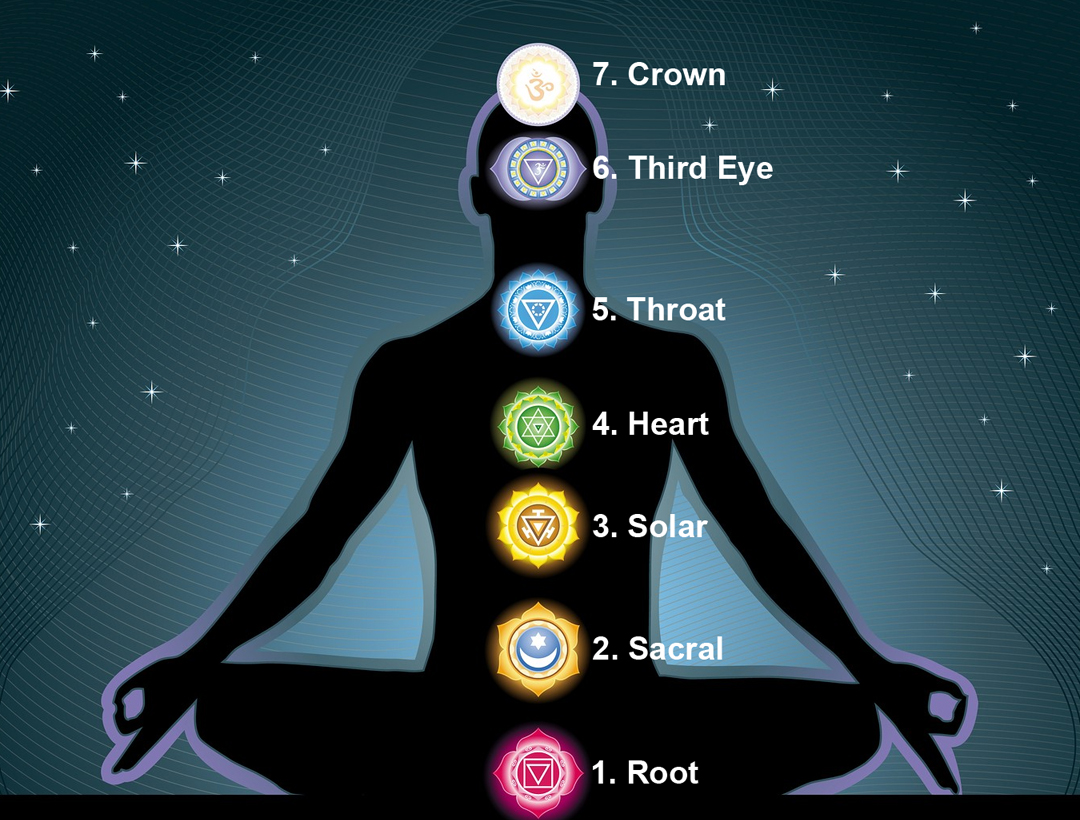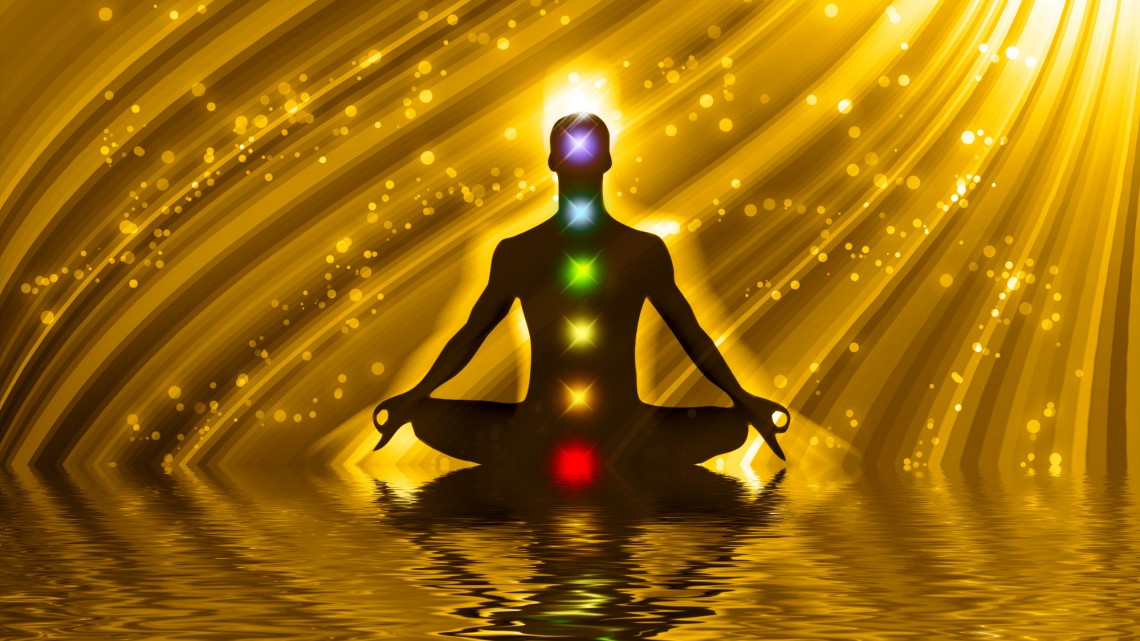If you are new to metaphysics, energy healing and/or crystals, or any other form of “new age” information, you may frequently come across the topic of chakras; an area that can be quite confusing. When I first saw the name pop up, I frequently asked myself, “What are chakras? And what do they do?” For those who have similar questions, this article should help clarify things, without going into too much depth.
What is a chakra?
Before we get into what chakras are, let’s first define what a chakra is. The word chakra is a Sanskrit term which means spinning wheel or vortex. We have seven main chakras that are aligned from the base of our spine to the top of our heads. These chakras are on different points of the body, even though they are aligned along the spine. One can imagine several whirling wheels of energy going from the base of their spine up to the top of their head. Here is a graphic which depicts where each chakra is located in our body:

“The chakras are specialized energy centers which connect us to the multidimensional universe. The chakras are dimensional portals within the subtle bodies which take in and process energy of higher vibrational nature so that it may be properly assimilated and used to transform the physical body.” – Richard Gerber in Vibrational Medicine
What do they do?
Chakras govern and bring energy into the nerve bundles and organs associated with each particular chakra; think of them as energy centres in which energy flows through in our body. The energy that is brought into and generated by the chakras is the same energy that electrifies our Universe and keeps us alive; known as life force, Prana, Chi, Qi and other terms in various cultures. Chakras help to fuel our body’s electrical system and keep it balanced. The chakras also manage our physical, mental, emotional and spiritual well-being.
Since energy is always moving throughout our body, through these energy centres, it is important that our seven chakras stay open, aligned and fluid. If there are any blockages then energy cannot flow. Think of a bathtub drain that’s stuck with hair for example. The bathtub backs up with water, decays and then eventually bacteria and mould begins to grow. Our bodies do the same when our chakras are blocked; problems occur. Problems such as illness, discomfort, and feeling physically and emotionally drained, or out of balance.
However, of course, our chakras are not physical like a bathtub so keeping them open can be a challenge. We must point out here that when we talk about chakras being open, what we actually mean is keeping them balanced. Too much or too little energy flowing through our chakras may effect the way we think, act and feel. For this beginners post, we won’t delve into why this may occur, or ways we can keep our chakras open and balanced. Instead, we’ll outline a few key facts about each chakra.
1. Root Chakra
The first chakra is located at the base of the spine. This chakra is known as the Root Chakra. The Sanskrit name for this chakra is Muladhara. This chakra is related to survival.
- The colour associated with this chakra is red.
- The element associated with this chakra is Earth.
- The lotus flower that is associated with this chakra is red and has four petals.
- Organs/systems/body parts that are governed by the root chakra: feet, back, reproductive organs, large intestine.
- Feelings associated with this chakra: security, well-being, grounded, stability.
- Crystals associated with this chakra: Bloodstone, Onyx, Red jasper.
- Foods associated with this chakra: root vegetables, red coloured fruits and vegetables.
- Signs of not enough energy flowing through this chakra: lack of energy, depression, insecurity, not feeling connected, financial issues, security issues.
- Signs of too much energy flowing through this chakra: greed, excess need for control.
2. Sacral Chakra
The second chakra is located between the navel and the pubic bone. This chakra is known as the Sacral Chakra. The Sanskrit word for this chakra is Svadhisthana. This chakra is related to emotion.
- The colour associated with this chakra is orange.
- The element associated with this chakra is water.
- The lotus flower that is associated with this chakra is orange and has six petals.
- Organs/systems/body parts that are governed by the sacral chakra: reproductive organs.
- Feelings associated with this chakra: creativity, sexuality, inspiration.
- Crystals associated with this chakra: Carnelian, Moonstone, Orange Quartz.
- Foods associated with this chakra: orange coloured fruits and vegetables, seafood.
- Signs of not enough energy flowing through this chakra: lack of creativity, fertility issues, reproductive health issues.
- Signs of too much energy flowing through this chakra: overly sexual, addiction, greed.
3. Solar Plexus Chakra
The third chakra is located about three inches above the navel and right below the breast bone. This chakra is known as the Solar Plexus Chakra. The Sanskrit word for this chakra is Manipura. This chakra is related to willpower.
- The colour associated with this chakra is yellow.
- The element associated with this chakra is fire.
- The lotus flower that is associated with this chakra is yellow and has ten petals.
- Organs/systems/body parts that are governed by the solar plexus chakra: the adrenal glands, pancreas, digestive system organs, liver and gall bladder.
- Feelings associated with this chakra: power and self confidence.
- Crystals associated with this chakra: Yellow Calcite, Amber, Citrine, Yellow Jasper.
- Foods associated with this chakra: yellow coloured fruits and vegetables.
- Signs of not enough energy flowing through this chakra: lack of willpower, low self-esteem, passive aggressiveness, poor digestion.
- Signs of too much energy flowing through this chakra: emotional outbursts, tendency to get stressed out easily.
4. Heart Chakra
The fourth chakra is located on the breastbone near the heart. This chakra is known as the Heart Chakra. The Sanskrit word for this chakra is Anahata. This chakra is related to love and compassion.
- The colour associated with this chakra is green.
- The element associated with this chakra is air.
- The lotus flower that is associated with this chakra is green and has twelve petals.
- Organs/systems/body parts that are governed by the heart chakra: heart, thymus, immune system.
- Feelings associated with this chakra: love.
- Crystals associated with this chakra: Rose Quartz, Green Aventurine, Jade, Malachite.
- Foods associated with this chakra: chocolate, green and pink coloured fruits and vegetables.
- Signs of not enough energy flowing through this chakra: inability to feel emotion, harshness, hopelessness.
- Signs of too much energy flowing through this chakra: lack of discernment.
5. Throat Chakra
The fifth chakra is located on the base of the neck. This chakra is known as the Throat Chakra. The Sanskrit word for this chakra is Vishuddha. This chakra is related to communication and creativity.
- The colour associated with this chakra is blue.
- The element associated with this chakra is aether.
- The lotus flower that is associated with this chakra is blue and has five petals.
- Organs/systems/body parts that are governed by this chakra: thyroid and parathyroid glands.
- Feelings associated with this chakra: communication, speaking up.
- Crystals associated with this chakra: Sodalite, Lapis Lazuli, Blue Kyanite.
- Foods associated with this chakra: blue coloured fruits and vegetables.
- Signs of not enough energy flowing through this chakra: anxiety, fear of communication, isolation, sore throat.
- Signs of too much energy flowing through this chakra: refusal to listen, needing to speak all of the time.
6. Third Eye Chakra
The sixth chakra is located on the face right between the eyebrows. This chakra is known as the Third Eye Chakra. The Sanskrit word for this chakra is Ajna. This chakra is related to perception, question and knowing.
- The colour associated with this chakra is indigo.
- The element associated with this chakra is light/dark.
- The lotus flower that is associated with this chakra is indigo with two petals.
- Organs/systems/body parts that are governed by this chakra: pineal, pituitary gland.
- Feelings associated with this chakra: clear vision, clear seeing, knowing.
- Crystals associated with this chakra: Amethyst, Azurite, Purple Fluorite.
- Foods associated with this chakra: purple coloured fruits and vegetables.
- Signs of not enough energy flowing through this chakra: inability to think clearly, headaches, vision problems.
- Signs of too much energy flowing through this chakra: feeling spaced out, hyperactivity, sinus problems, having trouble functioning in the physical world.
7. Crown Chakra
The seventh chakra is located on the top of the head. This chakra is known as the Crown Chakra. The Sanskrit word for this chakra is Sahasrara. This chakra is related to information and understanding.
- The colour associated with this chakra is white/violet.
- The element associated with this chakra is thought.
- The lotus flower that is associated with this chakra is a violet lotus with one thousand petals.
- Organs/system/body parts that are governed by this chakra: pituitary gland.
- Feelings associated with this chakra: enlightenment, awareness.
- Crystals associated with this chakra: Clear Quartz, Amethyst.
- Foods associated with this chakra: milk, white beans, bananas, foods grown in the sun.
- Signs of not enough energy flowing through this chakra: dementia, headaches, feeling sluggish.
- Signs of too much energy flowing through this chakra: light sensitivity, seizures, not feeling grounded, judgemental, feeling of being better than everyone else.
I hope that this overview has given you some insight into chakras and the way they work. The topic of chakras is vast and can go into a lot of depth, which probably isn’t ideal to cover in one post. However, it is hoped that if you were asking yourself, “What are chakras?” before reading this article, you have started to understand!
If you enjoyed this post, feel free to share it with your friends and family. After all, sharing is caring!
Author: Vex King
I am the founder and owner of the Bon Vita lifestyle brand. I could give myself a title and call myself a lifestyle entrepreneur, personal mentor, writer, designer, innovator, CEO, or anything else I see as fitting. However no title can define me as an individual. I’m just an optimist, a visionary, a philanthropist and jack of many trades. I’m using my positive influence to redefine the creative industries using Good Vibes Only #GVO so that people can fulfil their dreams, purposefully, and enjoy The Good Life #TGL. My daily words of intent are to make people… Think, look & feel GOOD!
Follow my social sites:














